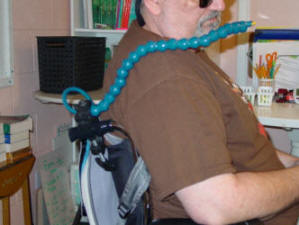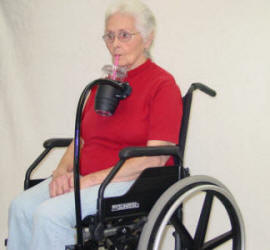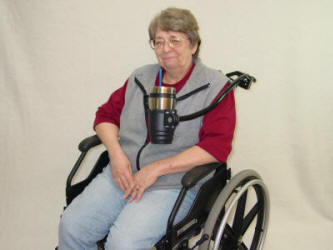Mealtime Partners, Inc.
Specializing in Assistive Dining and Drinking Equipment
May 2014 Independent Eating and Drinking Newsletter

|
May Topics:
|
||
|
Mealtime Partners Home Page Send a Comment or Suggestion |
|||
| Subscribe to Newsletters |
Breathing and Swallowing Revisited
For individuals with disabilities, the position of their body and their head, relative to their body, are extremely important to breathing and swallowing. Breathing and swallowing are functions that, for most people, are conducted fully automatically and present no problems. Everyone inhales and exhales ongoingly. If you didn’t, you would die within a few minutes. Additionally, swallowing is ongoing, but is different from just breathing in and out. Swallowing is required to clear saliva from the mouth throughout the day, which is a relatively automatic function, and to clear food and liquid from the mouth during eating and drinking. Breathing and swallowing must work together in a coordinated fashion and be synchronized to avoid choking or aspiration.
Even when swallowing saliva, the process of breathing and swallowing must be organized. There are several different phases involved in the progression of the saliva from the mouth to the stomach. The first phase is oral preparation where the saliva is organized in the mouth into a ball or bolus. Once a bolus is formed the second oral phase, the oral propulsive phase, moves the bolus to the back of the mouth. The pharyngeal phase is then initiated. The bolus is propelled from the mouth into the throat. At this point in the process activities involved with the swallow become fully automatic. As the bolus enters the pharynx, the larynx, or wind pipe, is closed to prevent what is being swallowed from going into the lungs. Breathing ceases for a moment as the bolus passes through the pharynx into the esophagus. This cessation of breathing is called the apneic event and the length of time that breathing stops is dependent, to a great degree, upon what has been swallowed. Swallowing saliva will cause a brief apneic event. Swallowing a bolus of chewed meat or crackers, however, will cause a significantly longer apneic event, as it is harder for the bolus to traverse the pharynx because it has a more dense texture, and in the case of crackers, is dryer than saliva.
Once the bolus is in the esophagus, the walls of the esophagus contract and relax to propel the bolus downward into the stomach. This is known as the esophageal phase and is the final phase of swallowing. The bolus enters the stomach through a valve, or sphincter. This sphincter is very important to the well-being of the esophagus as it closes after food has passed into the stomach and should stop the stomach contents from re-entering the esophagus. If the sphincter does not always close tightly enough to contain the stomach contents, it is known as reflux. Because the content of the stomach contains digestive acid, material that is regurgitated during reflux is acidic and can damage the lining of the esophagus. If the reflux spreads high enough up the digestive tract it is able to make contract with the pharynx. Individuals who have ongoing reflux often sound horse as their throat has been damaged by reflux.
When the breath swallow pattern is not well coordinated, the closure of the larynx may be incomplete or not take place at the correct time. If this happens, food or liquid can pass into the larynx and potentially can be inhaled into the lungs. This can cause aspiration pneumonia or, if the material that is inhaled is large enough, can partially or completely block the airway stopping air getting to the lungs. If the blockage is not removed rapidly it can cause death by asphyxiation.
Similarly, materials that pass from the stomach up through the digestive track when reflux occurs can be aspirated into the larynx and/or lungs. The acidic nature of the material can burn the larynx and lungs and pneumonia can result.
In conclusion, it should be remembered that for individuals who have severe disabilities, maintaining an appropriate position for safe breathing and swallowing is not always something that they can control independently, and they must depend upon a care provider to make sure that they are positioned appropriately. This article, and those referenced in the previous paragraph, are intended to provide insight for care providers, whether they are family members, friends, or paid caregivers, to allow them to provide better care for those who need assistance.
Because this subject is of such significance to safe eating and drinking, the second newsletter topic below addresses head positioning changes that can aid in breathing and swallowing. Also, Mealtime Partners has published many Newsletters that provide related information about the topic. More information can be found in the June 2009 Newsletter article "Promoting a Chin Tuck for Safer Eating", July 2009 Newsletter article "Positioning for Eating", March 2010 Newsletter article “Choking Prevention”, the July 2010 Newsletter article “Piecemeal Deglutination”, the October 2010 Newsletter article “Why we Choke”, and several other articles that can be accessed at our webpage: Newsletters.
- - - - - - - - - - - - - - - - - - - - - - - - - - - - - - - - - - - - - - - - - - - - - - - - - - - - - - - - - - - - - - - -
|
Hands-Free Drinking
Systems |
|||
| Many people with
disabilities suffer from some level of dehydration almost
constantly. However, for most individuals,
dehydration is 100% preventable. Being able to drink at will
is important to overall health and is significant to
quality of life. If someone can drink using a straw, they can most likely use one of Mealtime Partners hands-free drinking systems. A hands-free drinking system can enable them to drink independently so that they can keep themselves properly hydrated, and will not have to continuously depend on someone else to provide every sip of liquid for them. Mealtime Partners, Inc. has several different types of wheelchair mounted hands-free drinking systems to choose from: the Hydration Backpack with Drinking Tube Positioning; the Drink Aide; and the Front Mounted Drinking System. They can all be easily attached to a wheelchair and can be positioned to meet the individual user’s need. The Drink Aide bottle holds 28 fluid ounces and is suitable for someone who has good suction and can pucker their lips. The 70 fluid ounce Hydration Backpack is well suited for providing enough water to last for long periods without requiring replenishing. (A similar product is available for hospital bed mounting: the Hospital Bed Hydration System.) The Front Mounted Drinking System can hold cups, cans and other disposable containers for drinking a variety of beverages using a disposable straw. Because it holds user-provided disposable components, it is the easiest to clean and to replenish. |
|||
 |
|||
| Hydration Backpack with Drinking Tube Positioning | The Drink Aide | ||
  The Front Mounted Drinking System |
|||
| To view all of the Mealtime Partners drinking products, click here. For additional guidance about how to select the appropriate drinking system for your specific needs, click here. | |||
Most people sit with their head facing forward when they eat or drink. When not eating a meal many people lounge in a range of positions not really paying attention to how their head is situated when they take a drink or eat a snack. For those who have no deficiencies within their head and neck musculature, this behavior is acceptable; for those who do have deficiencies it can be dangerous. Some children are born with deficiencies within the structure of their mouth, throat and neck while other people acquire deficiencies because of injury or illness. Regardless of how the insufficiencies occur, they can be problematic when eating, drinking and swallowing in general. To help facilitate a safer swallow in these circumstances there are postural changes that can be made that will help improve eating and drinking performance for those people.
Chin Tuck – The chin should be lowered as if it is going to rest on the chest. However, it does not need to be dropped to an uncomfortable point. This position helps protect the airway during a swallow, thus reducing the risk of aspiration while eating and drinking.
Head Turn – When utilizing a head turn to improve swallowing performance the head should be turned towards the weak side of the throat. The head should be positioned as if you are going to look over your shoulder. This position is helpful for those who have a weakness on a single side of the larynx and/or pharynx. It allows the bolus to travel down the stronger side of the pharynx because the head maneuver opens the stronger side of the tube fully while contracting the weaker area.
Head Tilt – This position is achieved by moving the ear (on the weak side of the pharynx) towards the shoulder. Rather than a turn, as described above, the head is literally tilted to the side. This position should be tested if the head turn position described above does not assist in improving swallow performance. Both head-turn and head-tilt positions are designed to assist in swallowing using the stronger side of the pharynx.
Chin Up – This head position is used for those who are unable to move food from the front of their mouth, to the back of the mouth in preparation for swallowing. Once food is placed in the mouth and chewed, the chin can be raised to allow gravity to move food backwards in the oral cavity. This position should only be used by those who have oral food transit problems within their mouth. The position should only be undertaken when food needs to be moved back in the mouth. Maintaining this position constantly can be risky as food and liquid can dribble back in the mouth in an uncontrolled manner and cause choking. After the food has moved back, the head should be returned to a normal position.
Additionally, there are exercises that may help improve swallowing performance. Instruction and guidance for improving oral motor and swallowing performance should be sought from your physician or your speech language pathologist who also may be able to provide insight into other aspects of eating and drinking that are presenting problems.
- - - - - - - - - - - - - - - - - - - - - - - - - - - - - - - - - - - - - - - - - - - - - - - - - - - - - -
| Did You Know? Did you know that a cashew is not a nut? It is a fruit which comes from the cashew tree, a large evergreen tree that grows in tropical climates. The tree produces fruit that are described as cashew apples. The fruit is juicy and pulpy and is often added to fruit juices. The fruit is not the “nut” that we are so familiar with. Rather, at the bottom of the apple is a kidney shaped nut known as a drupe. The drupe contains toxins in its raw form (including anacardic acid, a toxin similar to that found in poison ivy). The drupes must be roasted and their shells removed to remove the toxins before they can be eaten. However, they must be roasted outdoors to avoid inhaling the smoke as it can be irritating to the lungs. Once roasted, the cashews change from gray/green to the light brown “nut” that is sold in stores. |
 |
| Cashew Apples |
Mealtime Partners Website Navigation:
Home | Dining | Drinking | Videos | All Products | Warranty | Ordering | Calendar | FAQ | Newsletters | Contact
Please send comments and suggestions to newsletters@mealtimepartners.com
Copyright © Mealtime Partners, Inc. 2014
All rights reserved.